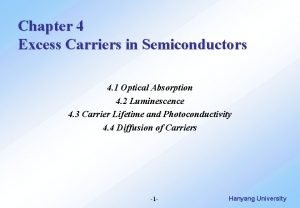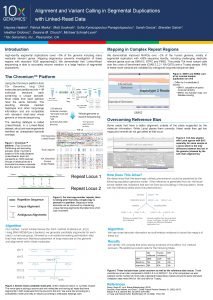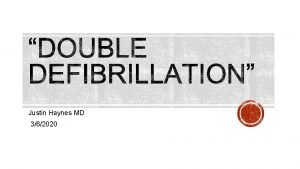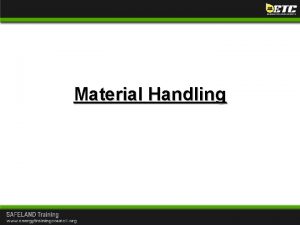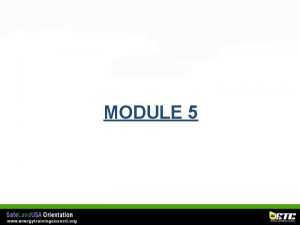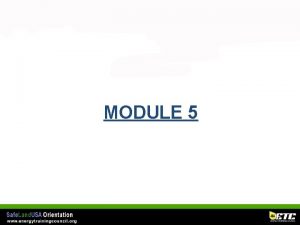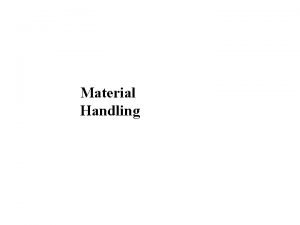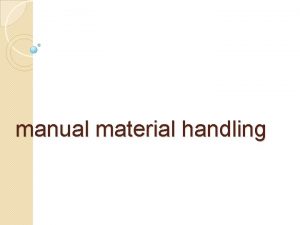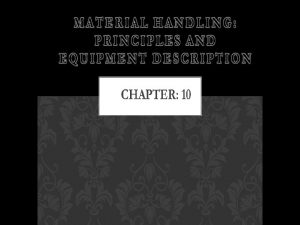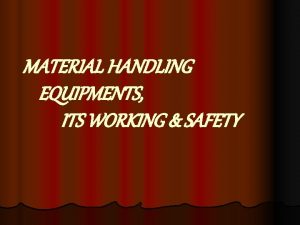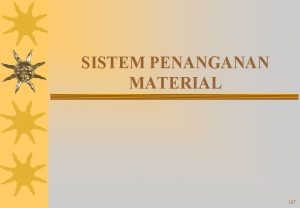Material handling Material handling Haynes defines Material handling









- Slides: 9

Material handling

Material handling � Haynes defines “Material handling embraces the basic operations in connection with the movement of bulk, packaged and individual products in a semi-solid or solid state by means of gravity manually or power-actuated equipment and within the limits of individual producing, fabricating, processing or service establishment”. � Materials handling can be also defined as ‘the function dealing with the preparation, placing and positioning of materials to facilitate their movement or storage’. � Material handling does not add any value to the product but adds to the cost of the product and hence it will cost the customer more.

� OBJECTIVES OF MATERIAL HANDLING � Following are the objectives of material handling: � 1. Minimize cost of material handling. � 2. Minimize delays and interruptions by making available the materials at the point of use at right quantity and at right time. � 3. Increase the productive capacity of the production facilities by effective utilization of capacity and enhancing productivity. � 4. Safety in material handling through improvement in working condition. � 5. Maximum utilization of material handling equipment. � 6. Prevention of damages to materials. � 7. Lower investment in process inventory.

SELECTION OF MATERIAL HANDLING EQUIPMENTS � Selection of Material Handling equipment is an important decision as it affects both cost and efficiency of handling system. The following factors are to be taken into account while selecting material handling equipment. � 1. PROPERTIES OF THE MATERIAL: Whether it is solid, liquid or gas, and in what size, shape and weight it is to be moved � 2. LAYOUT AND CHARACTERISTICS OF THE BUILDING � 3. PRODUCTION FLOW: If the flow is fairly constant between two fixed positions that are not likely to change, fixed equipment such as conveyors or chutes (tube) can be successfully used. � 4. COST CONSIDERATIONS

� 5. NATURE OF OPERATIONS: Selection of equipment also depends on nature of operations like whether handling is temporary or permanent � 6. ENGINEERING FACTORS: Engineering factors like door and ceiling dimensions, floor space, floor conditions and structural strength. � 7. EQUIPMENT RELIABILITY: Reliability of the equipment and supplier reputation and the after sale service also plays an important role in selecting material handling equipments.

MATERIAL HANDING EQUIPMENTS �Broadly material handling equipment’s can be classified into two categories, namely: �(a) Fixed path equipments: Fixed path equipments which move in a fixed path. �(b) Variable path equipments. : Variable path equipments have no restrictions in the direction of movement although their size is a factor to be given due consideration trucks, forklifts mobile cranes and industrial tractors belong to this category.

� 1. CONVEYORS � 2. INDUSTRIAL TRUCKS � 3. CRANES AND HOISTS � 4. CONTAINERS � 5. ROBOTS Follow pages 70, - 72

RELATIONSHIP BETWEEN PLANT LAYOUT AND MATERIAL HANDLING There is a close relationship between plant layout and material handling. A good layout ensures minimum material handling and eliminates re handling in the following ways: 1. Material movement does not add any value to the product so, the material handling should be kept at minimum though not avoid it. This is possible only through the systematic plant layout. Thus a good layout minimizes handling. 2. The productive time of workers will go without production if they are required to travel long distance to get the material tools, etc. Thus a good layout ensures minimum travel for workman thus enhancing the production time and eliminating the hunting time and travelling time.

� 3. Space is an important criterion. Plant layout integrates all the movements of men, material through a well designed layout with material handling system. � 4. Good plant layout helps in building efficient material handling system. It helps to keep material handling shorter, faster and economical. A good layout reduces the material backtracking, unnecessary workmen movement ensuring effectiveness in manufacturing. Thus a good layout always ensures minimum material handling.


